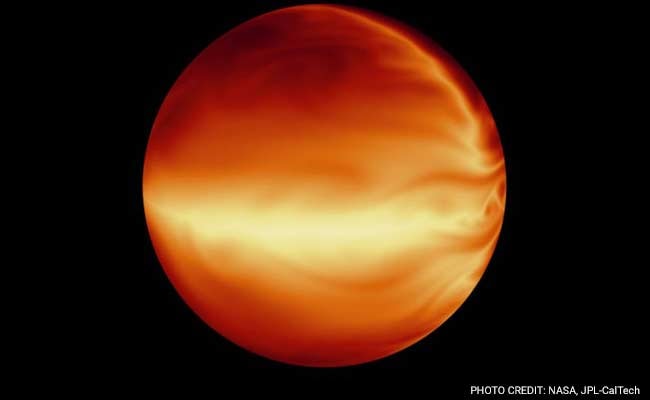
A simulation of HD 80606b based on data from NASA's Spitzer Space Telescope.
Hot Jupiters are exactly what they sound like. But it's how these Jupiter-like gas giants get so hot that's interesting: The planets orbit super-close to their host stars, creating incredibly hot worlds that undergo a whole slew of intriguing chemical reactions. Our Jupiter may be distant and cool by comparison, but in other solar systems, scientists have found, hot Jupiters are quite common.
In a study soon to be published in Astrophysical Journal Letters, researchers led by Julien de Wit of MIT report on the behavior of one of these hotties. By using the NASA Spitzer Space Telescope, they've learned some things about HD 80606b, a hot Jupiter 190 light-years from Earth.
HD 80606b is particularly interesting because it's in transit. Scientists think that hot Jupiters often start out as gas giants as far flung as the ones in our own solar system but then get roped in by the intense gravitational pull of their host star or another planet. HD 80606b seems to be in the middle of this process. It has an eccentric, comet-like trajectory, probably because it's still settling down from a trip across its solar system.
Every 111 days, the planet swings close to its sun-like host star before being flung back out. Scientists believe that one side of the planet gets hotter than the other during the closest encounter, perhaps heating up as much as 2,000 degrees Fahrenheit.
"As the planet gets closer to the star, it feels a burst of starlight, or radiation. The atmosphere becomes a cauldron of chemical reactions, and the winds ramp up far beyond hurricane force," study co-author Greg Laughlin of the University of California, Santa Cruz said in a statement.
The researchers think they have a pretty good idea of how long HD 80606b will stay in this wonky orbit - a good 10 billion years or so. They came to that time estimate by figuring out how "squishy" the planet is. Yes, squishy.
"If you take a Nerf ball and squeeze it a bunch of times really fast, you'll see that it heats up," Laughlin said in a statement. "That's because the Nerf ball is good at transferring that mechanical energy into heat. It's squishy as a result."
When a planet orbits close to a star, the planet gets squeezed by the star's gravitational force. If HD 80606b were "squishy," it would be better at dissipating that force as heat. But since HD 80606b doesn't seem pliable enough to dissipate much heat, it's going to spend a longer time developing a circular orbit.
"Our theories said it shouldn't take that long because we don't see migrating hot Jupiters very often," lead author de Wit said in a statement. HD 80606b could be an oddball, but it's possible that we just haven't observed enough hot Jupiters en route to know what's what.
© 2016 The Washington Post
(This story has not been edited by NDTV staff and is auto-generated from a syndicated feed.)
In a study soon to be published in Astrophysical Journal Letters, researchers led by Julien de Wit of MIT report on the behavior of one of these hotties. By using the NASA Spitzer Space Telescope, they've learned some things about HD 80606b, a hot Jupiter 190 light-years from Earth.
HD 80606b is particularly interesting because it's in transit. Scientists think that hot Jupiters often start out as gas giants as far flung as the ones in our own solar system but then get roped in by the intense gravitational pull of their host star or another planet. HD 80606b seems to be in the middle of this process. It has an eccentric, comet-like trajectory, probably because it's still settling down from a trip across its solar system.
Every 111 days, the planet swings close to its sun-like host star before being flung back out. Scientists believe that one side of the planet gets hotter than the other during the closest encounter, perhaps heating up as much as 2,000 degrees Fahrenheit.
"As the planet gets closer to the star, it feels a burst of starlight, or radiation. The atmosphere becomes a cauldron of chemical reactions, and the winds ramp up far beyond hurricane force," study co-author Greg Laughlin of the University of California, Santa Cruz said in a statement.
The researchers think they have a pretty good idea of how long HD 80606b will stay in this wonky orbit - a good 10 billion years or so. They came to that time estimate by figuring out how "squishy" the planet is. Yes, squishy.
"If you take a Nerf ball and squeeze it a bunch of times really fast, you'll see that it heats up," Laughlin said in a statement. "That's because the Nerf ball is good at transferring that mechanical energy into heat. It's squishy as a result."
When a planet orbits close to a star, the planet gets squeezed by the star's gravitational force. If HD 80606b were "squishy," it would be better at dissipating that force as heat. But since HD 80606b doesn't seem pliable enough to dissipate much heat, it's going to spend a longer time developing a circular orbit.
"Our theories said it shouldn't take that long because we don't see migrating hot Jupiters very often," lead author de Wit said in a statement. HD 80606b could be an oddball, but it's possible that we just haven't observed enough hot Jupiters en route to know what's what.
© 2016 The Washington Post
(This story has not been edited by NDTV staff and is auto-generated from a syndicated feed.)
Track Latest News Live on NDTV.com and get news updates from India and around the world

